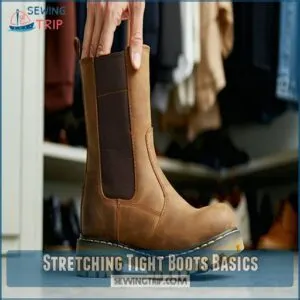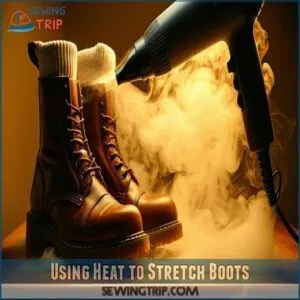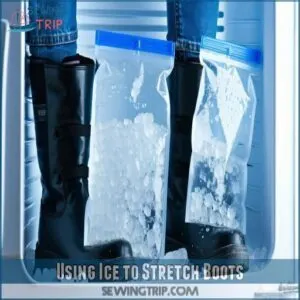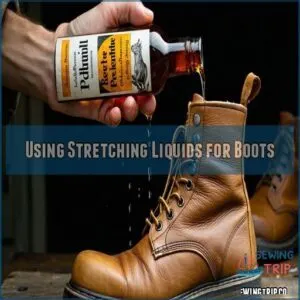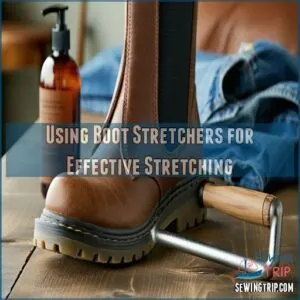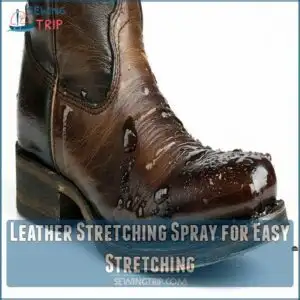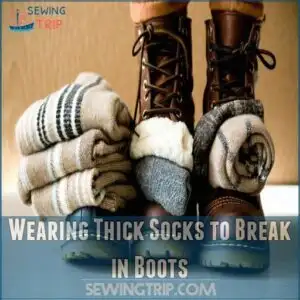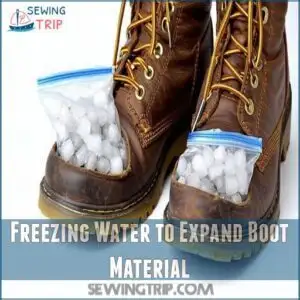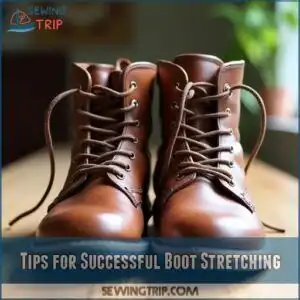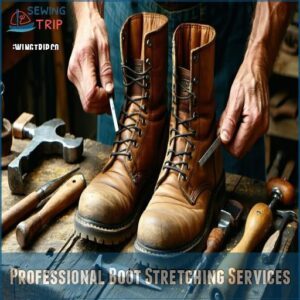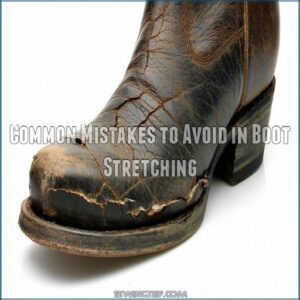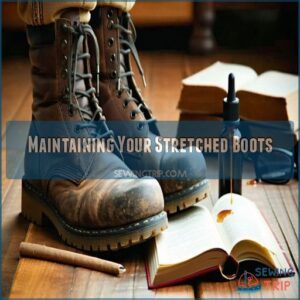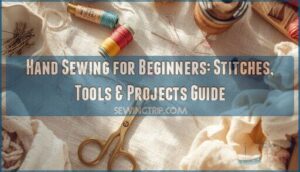This site is supported by our readers. We may earn a commission, at no cost to you, if you purchase through links.
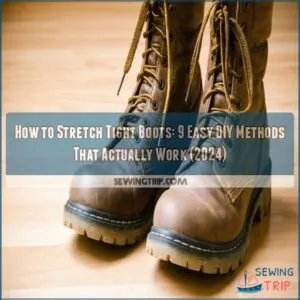
Wear thick socks, slip on the boots, and blast them with warm air for about 30 seconds on tight spots.
Wiggle those toes!
It’s like training your boots in a mini boot camp.
Alternatively, for a wet workout, soak them briefly, then wear them damp to mold perfectly to your feet.
Just remember, leather’s like a fine wine—it needs some TLC.
Massage conditioner in while drying to keep them happy.
Curious about more boot-stretching secrets?
Stick around, we’ve got the lowdown on methods that’ll have your feet dancing in comfort.
Table Of Contents
- Key Takeaways
- Stretching Tight Boots Basics
- How to Stretch Tight Boots at Home
- Best Methods for Stretching Leather Boots
- Tips for Successful Boot Stretching
- Stretching Different Types of Boots
- Preventing Boots From Shrinking
- Professional Boot Stretching Services
- Common Mistakes to Avoid in Boot Stretching
- Maintaining Your Stretched Boots
- Frequently Asked Questions (FAQs)
- Conclusion
Key Takeaways
- Use a hairdryer with thick socks to warm and expand tight areas in your boots. Flex your toes to help loosen leather while keeping the dryer moving to avoid damage.
- Try the freezer method: place water-filled freezer bags inside your boots and leave them overnight. The expanding ice will gently stretch tight spots.
- Use leather stretching spray or homemade solutions to dampen tight areas, wear thick socks, and walk around as the boots dry for a custom fit.
- Invest in boot stretchers for precise adjustments. Choose between one-way for width or two-way for both width and length, and leave them in overnight for best results.
Stretching Tight Boots Basics
You don’t have to let those perfect boots collect dust in your closet just because they’re a bit tight on your feet.
Whether you’ve got leather ankle boots pinching your toes or tall riding boots squeezing your calves, you’ll find that stretching your boots at home is easier than you think, and you won’t need to break the bank to get that perfect fit.
Why Boots Need Stretching
Breaking in new boots can feel like a wrestling match with stubborn leather.
Your favorite footwear might be too snug, causing discomfort that makes you dread wearing them.
One way to tackle this issue is by investing in a leather boot stretcher to gently ease the material.
Here’s why stretching matters:
- Prevents painful blisters and foot fatigue during the break-in period
- Saves money by making slightly-too-tight boots wearable instead of collecting dust
- Extends boot life by reducing stress on seams and materials
You’re not stuck with uncomfortable boots – let’s fix that.
Importance of Proper Fit
You wouldn’t wear shoes that pinch your toes or rub your heels raw, so why settle for ill-fitting boots?
Proper fit isn’t just about comfort – it’s about protecting your foot health and preventing painful blisters.
When your boots fit right, you’ll walk with confidence, avoid long-term foot problems, and actually want to wear them.
Plus, well-fitting boots last longer since they’re not straining at the seams.
How Stretching Affects Boot Material
Different boot materials react uniquely when stretched.
Leather expands gradually and molds to your foot shape, while synthetic materials might snap back to their original form.
Natural materials like suede and full-grain leather offer the most flexibility, stretching up to half a size larger.
But be careful – stretching beyond a material’s limits can cause permanent damage, creating unsightly wrinkles or even tears.
How to Stretch Tight Boots at Home
You don’t have to let those pinching boots collect dust in your closet when you can stretch them at home using simple items like a hairdryer, ice, or a boot stretcher.
These proven DIY methods will help you customize the fit without damaging your favorite footwear.
Whether your boots are leather or synthetic, these proven DIY methods will help you customize the fit without damaging your favorite footwear.
Using Heat to Stretch Boots
Heat transforms stubborn boots into perfect-fitting footwear when used correctly.
Start by wearing thick socks, then aim a hairdryer at tight spots for 30 seconds.
Keep the dryer moving to prevent damage, and flex your toes while the leather’s warm.
For synthetic boots, stick to lower heat settings around 80°F.
After stretching, apply leather conditioner to prevent drying and maintain the boot’s integrity.
Using Ice to Stretch Boots
The freezer method works wonders for stretching tight boots naturally.
Conversely, if you’re trying to shrink your boots, you may want to try the opposite approach, using heat to manage the material, as seen in methods for how to shrink shoes.
Fill two freezer-safe bags with water, removing excess air, and position them snugly in the areas needing stretch.
Place your boots in the freezer for 8-12 hours – as water freezes, it expands, gently pushing against the material.
Let the ice melt completely before removing the bags.
For stubborn spots, repeat the process.
Using Stretching Liquids for Boots
Stretching liquids are really helpful for breaking in stubborn boots.
Mix equal parts rubbing alcohol and water for a DIY solution, or grab a commercial stretching liquid from your local shoe store.
Simply dampen the tight spots, slip on thick socks, and wear your boots until they dry completely.
For extra stretch, reapply the solution and repeat the process until you achieve your desired fit.
Using Boot Stretchers for Effective Stretching
After struggling with tight boots, consider that even raw denim, which has shown to have varying levels of stretch potential depending on fabric weight, can be a good indicator of how much some stiff materials can give, a boot stretcher can be your secret weapon for achieving that perfect fit. Just pop it in, turn the handle, and let it work its magic overnight.
- Choose between one-way stretchers for width and two-way for both length and width
- Apply leather conditioner before stretching to prevent damage
- Start with gentle pressure and increase gradually
- Leave the stretcher in for 24-48 hours for best results
Best Methods for Stretching Leather Boots
You’ll find that stretching leather boots doesn’t have to be a pain in the foot, especially when you’ve got the right tools and techniques ready to go.
Whether you’re planning to use a boot stretcher, thick socks, or even the trusty freezer method, you’ll discover that transforming those tight leather boots into your perfect fit is easier than you might think.
Leather Stretching Spray for Easy Stretching
Ready to give your leather boots new life?
Leather stretching spray offers a gentle yet effective way to expand tight spots without damaging the material.
Just spray the tight areas until damp, slip on thick socks, and wear your boots for 30 minutes.
Don’t overdo it – a light misting is all you need.
For stubborn spots, combine with a boot stretcher overnight for maximum results.
Using a Hairdryer to Soften Leather
The hairdryer method works like a charm for those stubborn leather boots.
Hold your hairdryer 6 inches from the tight spots, moving it constantly to prevent heat damage.
Aim for 20-30 seconds per area – just enough to warm the leather, not cook it.
Flex and wiggle your feet while the leather’s warm to help it mold to your shape.
Let the boots cool completely before wearing them.
Wearing Thick Socks to Break in Boots
You’ve probably heard the old saying about thick socks stretching boots – and it’s true!
Layer up with two pairs of socks (ideally wool) and wear your boots for 30-minute sessions.
Start with 4-5 daily sessions, gradually increasing wear time as the leather gives.
While you might feel like a penguin waddling around, this tried-and-true method helps prevent blisters and molds the boots to your feet’s unique shape.
Freezing Water to Expand Boot Material
Transform your tight boots into the perfect fit using the freezer method – it’s like giving your boots a winter makeover.
Fill freezer-safe bags halfway with water, squeeze out excess air, and position them inside your boots where you need extra room.
Pop them in the freezer overnight, letting science do the work as the expanding ice gently stretches the material.
Just remember to let everything thaw completely before removing the bags.
Tips for Successful Boot Stretching
You’ll need more than just elbow grease to stretch those stubborn boots without damaging them, and we’ve got the proven tips you’ve been looking for.
Whether you’re dealing with pinched toes or tight calves, these expert-tested strategies will help you safely expand your boots while preserving their shape and material.
Avoiding Damage to Boot Material
When stretching boots, protecting the material is just as important as achieving the perfect fit.
Smart precautions prevent costly damage and extend your boots’ lifespan.
Here’s what experienced cobblers watch out for:
- Never apply direct heat to delicate suede or patent leather
- Keep water exposure brief to prevent warping and discoloration
- Avoid harsh chemicals that can strip protective finishes
- Test stretching solutions on a hidden spot first
Knowing Limits of Stretching
Although every boot has stretching potential, it’s important to know their limits.
Most boots can stretch up to half a size larger, while leather boots might give you up to a full size of wiggle room.
Don’t push synthetic materials too far – they’ll snap back to shape or potentially tear.
If you’re hoping for more than a size increase, you’re better off visiting a professional cobbler.
Using Conditioners to Prevent Dryness
Three essential leather conditioners keep your boots supple during the stretching process.
You can find a variety of leather care products, including ones suitable for leather cream boots, at online marketplaces like leather cream boots online.
Apply a high-quality conditioner like mink oil, leather cream, or beeswax after each stretching session to prevent cracking and maintain flexibility.
Don’t skimp on conditioning – a dry boot won’t stretch effectively and might crack under pressure.
For best results, work the conditioner into the leather using circular motions, focusing on stretched areas.
Storing Boots to Maintain Shape
Picture those beloved boots slumping over like tired soldiers after a long day.
To keep their shape while stored, stuff them with acid-free tissue paper or boot trees.
Don’t use newspaper – the ink can transfer and stain the interior.
For tall boots, try pool noodles cut to size.
Store them upright in a cool, dry place away from direct sunlight to prevent material warping.
Choosing The Right Boot Stretcher
Choosing the right boot stretcher isn’t rocket science once you know what to look for.
You’ll find 1-way stretchers that focus on width and 2-way stretchers that tackle both width and length issues.
Wooden stretchers offer durability and a pleasant scent, while plastic options are budget-friendly and portable.
Just remember to pick a boot stretcher, not a shoe stretcher – they’re different tools with unique purposes.
How to Use a Boot Stretcher Correctly
Getting your boot stretcher to work its magic isn’t rocket science.
Insert the stretcher until it snugly fits the toe area, then turn the handle clockwise in small increments.
Don’t rush – stretch gradually over 24-48 hours.
Check progress every 8 hours and adjust the pressure if needed.
Once you’ve reached your desired fit, remove the stretcher slowly to avoid damaging the boot’s shape.
Benefits of Using a Boot Stretcher
Boot stretchers put you in complete control of your footwear’s fit.
Now that you’ve mastered using one correctly, let’s explore why they’re worth the investment.
Here’s what makes boot stretchers stand out:
- You’ll get precise, targeted stretching exactly where you need it
- The durable construction means you can use them repeatedly for years
- They work while you sleep, no active effort required
Plus, they’re more reliable than hit-or-miss methods like hoping boots stretch naturally.
Alternatives to Boot Stretchers
Don’t have a boot stretcher? No problem. You’ve got plenty of effective alternatives right in your home, just like having the right outdoor fabric, such as water-resistant Sunbrella fabric, can make all the difference in your gear.
Here’s a quick comparison of DIY methods that work just as well:
| Method | Time Required | Effectiveness | Cost | Best For |
|---|---|---|---|---|
| Thick Socks | 2-3 days | Moderate | Free | All boots |
| Freezing Water | Overnight | High | Free | Leather |
| Homemade Spray | 1-2 hours | High | $5 | Suede/leather |
| Hair Dryer | 1-2 hours | High | Free | Leather |
| Newspaper Stuffing | Overnight | Low | Free | All materials |
Stretching Different Types of Boots
You’ll find that stretching boots made of different materials isn’t a one-size-fits-all process, as leather, synthetic, and rubber boots each need their own special approach.
Whether you’re trying to stretch those knee-high riding boots or your favorite ankle booties, you’ll learn the right technique for your specific type of footwear.
Stretching Tall Boots and Short Boots
Whether you’re dealing with knee-highs or ankle boots, the stretching technique you’ll need varies.
Tall boots often need calf adjustments, while short boots typically require focus on the toe box and instep areas.
Here’s what you’ll want to keep in mind:
- Use a specialized boot stretcher with extra-long handles for tall boots
- Focus on sectional stretching for knee-highs to maintain shape
- Apply stretching spray evenly throughout the shaft
- Consider using boot shapers between wears to prevent collapsing
Stretching Synthetic and Rubber Boots
Stretching synthetic and rubber boots follows a different playbook than leather.
You’ll need specialized techniques since these materials don’t naturally expand like leather does.
Synthetic materials often have a bit of four-way stretch, similar to activewear fabric stretch, but this doesn’t necessarily make them easier to stretch.
Here’s what works best:
| Method | Effectiveness | Time Needed |
|---|---|---|
| Heat Method | High Risk | 15-20 mins |
| Boot Stretcher | Moderate | 24-48 hrs |
| Double Socks | Low Impact | 1-2 weeks |
Remember, synthetic materials often bounce back to their original shape, so you might need to repeat the process several times.
Stretching Boots With Different Materials
Different boot materials demand unique stretching approaches.
While leather boots respond well to moisture and heat, synthetic materials need gentle, consistent pressure.
Suede calls for specialized suede spray and careful stretching to avoid damage.
Canvas boots benefit from a combination of water and wear, letting them naturally conform to your feet.
Rubber boots? They’ll give in with time and proper boot stretchers.
Considerations for Stretching Specific Boot Styles
Each boot style needs its own special approach for the perfect stretch. Just like we discussed with materials, your trusty cowboy boots won’t respond the same way as those sleek ankle boots. Here’s what you need to know:
- Cowboy boots benefit most from leather stretching spray and a boot shaft stretcher
- Ankle boots stretch best with the two-sock method and targeted heat
- Work boots often need professional stretching due to their reinforced toes
Preventing Boots From Shrinking
You’ve spent good money on your boots, and there’s nothing worse than finding they’ve shrunk after getting caught in the rain or sitting unused in your closet.
By following a few simple maintenance steps, you’ll keep your boots fitting perfectly and prevent that dreaded tight squeeze that makes you want to kick them off.
Conditioning Leather to Prevent Shrinkage
Every few weeks, leather boots crave a good conditioning to prevent shrinkage and maintain their shape.
You’ll want to use a high-quality leather conditioner – think of it as moisturizer for your boots.
Work the conditioner into the leather using circular motions, paying extra attention to creases and high-wear areas.
Let it absorb for 24 hours, and your boots will thank you with supple, shrink-resistant leather.
Storing Boots Properly to Maintain Shape
During storage, your boots need proper support to maintain their shape and prevent unwanted creases.
Store them upright using boot shapers or stuff them with acid-free paper – old newspapers can leave ink stains.
For tall boots, invest in boot trees or use pool noodles cut to size.
Keep them in a cool, dry closet with good airflow, and rotate your boots regularly to prevent pressure points.
Avoiding Water Damage to Boots
Keeping your boots dry isn’t just about avoiding puddles – it’s about preserving their shape and preventing unwanted shrinkage.
Never soak your boots in water, as this can damage the material and cause permanent distortion.
Instead, use waterproofing sprays before wear and let them dry naturally away from direct heat sources.
If they do get wet, stuff them with paper towels and replace as needed throughout the drying process.
Using Stuffing to Maintain Boot Shape
While protecting boots from water damage is important, maintaining their shape is just as essential.
Smart stuffing keeps your boots standing tall and crease-free.
Here’s what works best:
- Cedar shoe trees absorb moisture and fight odors
- Acid-free paper prevents material breakdown during storage
- Pool noodles cut to size offer budget-friendly support
For best results, stuff your boots right after wearing them while they’re still warm and pliable.
Professional Boot Stretching Services
If you’ve tried DIY methods without success, you’ll want to think about taking your boots to a professional cobbler who can safely stretch them using specialized equipment.
While it’ll cost you more than stretching boots at home, you’ll get expert service that can extend the life of your favorite boots and guarantee they fit perfectly.
Benefits of Professional Boot Stretching
You might think stretching boots at home sounds simple, but getting expert care does wonders.
Professional boot stretching guarantees your beloved pair gets personalized solutions for a lasting fit, all while preserving their value.
Skilled hands help avoid damage and make sure your boots stretch correctly, so they remain comfy and stylish without the DIY hassle.
Finding a Reliable Cobbler or Shoe Repair
Need help finding a local cobbler or shoe repair service?
Start by checking cobbler reviews online, and don’t hesitate to ask friends for cobbler recommendations.
Consider also exploring online options for a boot stretching service.
Local shops often provide personalized service and detailed cobbler services to meet your needs.
Before committing, inquire about shoe repair costs to make sure you’re getting the best bang for your buck.
What to Expect From Professional Stretching
Expect a seamless process when using professional boot stretching services.
They’ll evaluate your boots and know just where to stretch—reducing risks like overstretching or damage.
You’ll hand over your boots, then return to find them fitting perfectly.
Results vary, taking anywhere from a day to a week.
It’s like sending your shoes on a spa retreat!
Cost of Professional Boot Stretching
Ever wonder what professional boot stretching costs?
Prices vary based on several factors like boot type and specific needs.
Generally, you might see:
- Cost Comparison: $20-$50 for leather boots
- DIY vs. Professional: Pros handle delicate materials better
- Value for Money: Priceless comfort from perfectly stretched boots
Balancing these can make opting for pros worthwhile!
Common Mistakes to Avoid in Boot Stretching
Don’t wreck your favorite boots by stretching them too far; remember to think about the material’s limits and avoid common pitfalls like ignoring the type of leather or neglecting essential conditioning.
Don’t wreck your favorite boots by stretching them too far; remember to think about the material’s limits and avoid common pitfalls like ignoring the type of leather or neglecting essential conditioning.
Overstretching Boots
Stretching boots professionally guarantees precision, but when you’re home alone, avoid overstretching.
Going too far can damage those expensive boots, void warranties, or even render them non-returnable.
Knowing how to work with fabrics that have some give, like moderate stretch fabric options, can be helpful in understanding the limits of stretching materials.
It’s like pulling a sweater until it unravels; nobody wants that.
So, know your size limitations—aim for comfort, not catastrophe. Keep your boots fitting snugly, not tearfully.
Underestimating Material Limits
Boot limits can sneak up on you.
Stretch leather and synthetic boots within their material limits, or risk damage.
You might feel like a boot-stretching wizard, but too much stretch can tear, while too little leaves you wincing.
Test gently and gradually, respecting each material’s nature.
Your feet will thank you—and so will your boots.
Ignoring Material Type
Don’t overlook the boot’s material type.
Synthetic boots and rubber boots behave differently than leather.
Material-specific methods matter.
Using the wrong technique can lead to frustration.
Think of a time you tried fitting a square peg in a round hole—same with boots!
Respect what the boot’s made of, or you’ll end up with a shoe catastrophe.
Failing to Condition Leather
Just like a couch potato, leather left untreated tends to crack and dry, cutting short your boot’s lifespan.
You wouldn’t skip moisturizer in winter, so why ignore your boots?
Conditioning leather regularly shields against dryness and uneven wear, saving on repair costs over time.
If you want to avoid expensive fixes, conditioning isn’t just an option; it’s necessary.
Maintaining Your Stretched Boots
You’ve finally stretched your boots to the perfect fit, but don’t abandon them now!
Regular conditioning, proper storage, and occasional wear will maintain their comfort and keep them from shrinking back.
Regular Conditioning for Leather Boots
Your stretched boots are feeling good, but like any relationship, they need a little care to stay in great shape.
Regular conditioning with the right leather care products keeps them supple and avoids cracking.
Use conditioning tools and stick to the right conditioning frequency depending on the leather type.
Trust us, your boots will thank you by looking sharp and lasting longer.
Storing Boots to Prevent Damage
Keeping your boots in tip-top shape after stretching is key.
Proper boot storage is like giving them a comfy vacation.
Stuff them with boot trees to maintain their shape, preventing creases and unwanted shrinking.
Store them in a cool, dry place—avoid attics or basements with fluctuating humidity.
These simple boot storage tips will keep your investment looking great for years.
Wearing Boots Regularly to Maintain Fit
Once your boots are stored properly, wearing them regularly is key to maintaining their fit.
Think of it like breaking in new boots! Regular wear helps keep them comfortable and prevents stiffness.
Here’s how:
- Wear boots around the house weekly.
- Take seasonal strolls to maintain shape.
- Include them in your foot care routine.
Your feet and boots will thank you!
Adjusting
After wearing them regularly, it’s time to fine-tune your boots.
Adjusting for comfort involves tweaking calf adjustments and considering heel height.
Let’s make sure they hug you perfectly, not pinch.
| Adjustment | Focus Area | Benefit |
|---|---|---|
| Boot width | Toe shape | Improved fit |
| Heel | Height | Enhanced balance |
| Calf | Size | Increased comfort |
| Insole | Support | Arch stability |
| Laces | Flexibility | Custom snugness |
Frequently Asked Questions (FAQs)
Can leather boots stretch out fast?
Sure, leather boots can be stretched quickly, but it’s not instant.
Use a hairdryer with thick socks to loosen them up.
Cobbler for faster, reliable results.
How do you stretch leather boots?
Use a hairdryer to warm tight spots, then move your feet and toes to expand leather boots.
Wear thick socks or apply stretching spray, and if needed, use boot stretchers for extra space without damaging them.
How to stretch boots at home?
Back in my day, we used brute force! Try wearing thick socks, then heat-stretching with a hairdryer. Freezing wet bags inside also works wonders, but patience is key.
How to stretch leather boots with thick socks?
Wear thick socks and put on your leather boots.
Use a hairdryer to gently heat tight areas while wiggling your toes.
This softens the leather, allowing a better fit as the material stretches over time.
How far can you stretch a leather boot?
Imagine wriggling your toes and suddenly feeling like Cinderella.
Sadly, leather boots stretch only up to one size max.
Use boot stretchers or thick socks with heat to ease that small—and slightly magical—transformation.
How long does it take to stretch leather boots?
Stretching leather boots can take anywhere from several hours to a few days.
It depends on the method used, like heat, ice, or boot stretchers.
Patience is key for achieving the perfect fit.
What is the best way to stretch tight boots?
Tight boots are like stubborn pets needing gentle coaxing.
Try a DIY solution: apply a mixture of rubbing alcohol and water, wear thick socks, and use heat from a hairdryer to help them stretch comfortably.
How do you break in tight boots?
Break in tight boots by wearing thick socks and walking around the house.
Use a hairdryer to warm them slightly, flex your feet to mold them, and don’t forget some leather conditioner to keep them soft.
Can I stretch my boots with a hair dryer?
Yes, you can stretch your boots using a hairdryer.
Wear thick socks, warm the tight spots with the dryer, and flex your feet.
Avoid prolonged heat to prevent damage, and apply leather conditioner afterward.
How to make boots fit tighter?
So, your boots are a bit loose? Try thicker socks, insoles, or even boot inserts. These simple additions create a snugger fit, instantly solving your problem. Problem solved!
Can stretching damage the boots original structure?
Stretching boots can alter their original structure if done excessively or improperly.
Techniques involving heat or liquid might weaken materials.
It’s wise to stretch gradually and consult a professional if you’re unsure about DIY methods.
How long does stretching take to be effective?
It typically takes about 24 to 48 hours for stretching methods, like using boot stretchers, to show results.
Patience is key; repeat the process as needed.
For quicker outcomes, consider professional stretching if you’re pressed for time.
Is ice stretching safe for all boot materials?
Ice stretching is effective for some materials but not all.
While it’s a cool trick for leather, it can crack or warp synthetic and delicate materials.
Always test a tiny area first to avoid unwanted boot damage.
What are alternatives if stretching fails?
If stretching won’t cut it, you’ve got options like selling or donating them, trading in for a bigger size, or enlisting a cobbler’s help to adjust the boots.
New boots might be your ultimate solution.
Does stretching affect waterproof boots?
Stretching waterproof boots could compromise their waterproofing by altering the material or seams.
Proceed with caution, as this might turn your boot into a sponge rather than a barricade against puddles.
Consider consulting a professional first.
Conclusion
So, you’ve wrestled with tight boots, right?
Don’t worry, you’re not alone!
We’ve covered tons of ways to successfully stretch tight boots.
Remember, patience is key; forcing them could damage your footwear.
From hairdryer heat to freezer tricks and even store-bought boot stretchers, you now have the knowledge to conquer those stubborn boots.
With the right approach to how to stretch tight boots, you’ll be strutting comfortably in no time.
Happy stepping!

